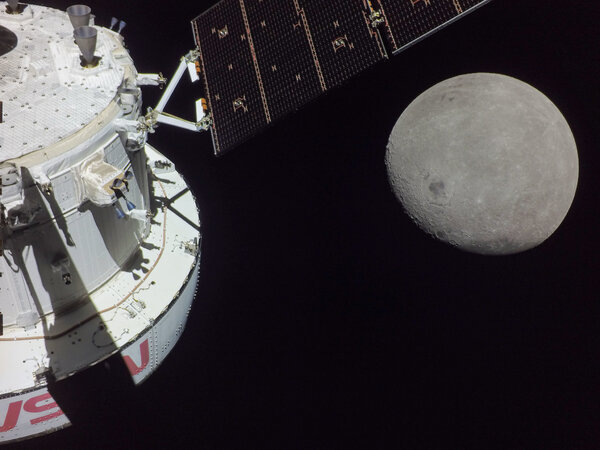One other day, one other rocket launch by SpaceX, and one other spacecraft going to the moon. All these appear commonplace as of late.
SpaceX has already launched its Falcon 9 rocket greater than 50 occasions this 12 months. NASA’s Artemis I, an uncrewed check flight that could be a precursor to future astronaut missions, is nearing its return to Earth after orbiting the moon. CAPSTONE, a small NASA-sponsored CubeSat, remains to be orbiting the moon after being launched in June. A robotic South Korean orbiter, Danuri, was launched to the moon in August.
However the lunar lander that was carried by a Falcon 9 rocket from Cape Canaveral, Fla., on Sunday shouldn’t be a NASA mission. As an alternative, referred to as M1, it’s from a small Japanese firm, Ispace. The payloads on M1 embrace a rover from the United Arab Emirates and a small two-wheeled Transformers-like robotic for the Japanese house company.
Whereas the mission lifted off at 2:38 a.m. Jap time, you’ll have to attend till April to see if these robotic explorers make it there, presumably turning into the primary cargo efficiently carried to the lunar floor by a personal firm.
What’s Ispace, and what’s it sending to the moon?
The corporate began as one of many opponents for the Google Lunar X Prize, a contest that provided a $20 million prize for the primary non-public spacecraft to land on the moon, journey 500 meters and ship again video from the lunar floor.
On the time, the Japanese group, referred to as Group Hakuto, targeted on creating a rover, and it was to depend on a competing group from India for the experience to the floor of the moon. If that had labored, the 2 rovers would have been racing to see which might journey the five hundred meters first.
Nonetheless, the Lunar X Prize expired earlier than any of the groups made it to the launchpad. An Israeli competitor, SpaceIL, launched its craft in 2019, however its moon lander crashed on the lunar floor.
The group referred to as Group Hakuto developed into Ispace, attracting sizable funding, and the corporate plans to launch a collection of business moon landers within the coming years.
For Sunday’s mission, the payloads embrace the Rashid lunar rover from the Mohammed Bin Rashid House Heart in Dubai; a two-wheeled “transformable lunar robotic” from JAXA, the Japanese house company; a check module for a solid-state battery from NGK Spark Plug Firm; a man-made intelligence flight pc; and 360-degree cameras from Canadensys Aerospace.
As a vestige of its Lunar X Prize heritage, additionally it is carrying a panel engraved with the names of people that supplied crowdfunding assist and a music disc with a track carried out by the Japanese rock band Sakanaction.
The Japanese firm’s lander shouldn’t be the one passenger on Sunday’s flight. A secondary payload on the Falcon 9 is a small NASA mission, Lunar Flashlight, which is to enter an elliptical orbit across the moon and use an infrared laser to probe the deep, darkish craters on the moon’s polar areas.
Why will it take Ispace so lengthy to get to the moon?
Very like another current moon missions, M1 is taking a circuitous, energy-efficient journey to the moon and won’t land, within the Atlas Crater within the Northern Hemisphere of the moon, till late April. The fuel-efficient trajectory permits the mission to pack in additional payload and carry much less gas.
What are the moon’s different current guests?
As a part of the Artemis I mission, NASA’s Orion spacecraft traveled to, then orbited, the moon. It would return to Earth in a while Sunday, with a splashdown into the Pacific Ocean.
A small NASA-financed mission referred to as CAPSTONE additionally arrived not too long ago to discover an orbit wherein NASA plans to construct a lunar outpost the place astronauts will cease on the way in which to the moon.
And whereas it hasn’t arrived but, the moon will get a 3rd new customer subsequent month. Danuri, a South Korean house probe, was launched in August and is because of enter lunar orbit on Dec. 16. The spacecraft will assist the event of expertise for future Korean missions, and it additionally carries scientific devices to check the moon’s chemical composition and magnetic subject.
Are different firms making an attempt what Ispace is doing?
A NASA program referred to as Business Lunar Payload Companies, or CLPS, has been trying to ship experiments to the floor to the moon. The primary two missions, from Intuitive Machines of Houston and Astrobotic Expertise of Pittsburgh, plan to launch subsequent 12 months after appreciable delays. Intuitive Machines’ lander, which might be launched as early as March, might even beat Ispace to the moon as a result of it’s utilizing a fast six-day trajectory.
As a result of it’s not an American firm, Ispace couldn’t immediately take part within the NASA program. Nonetheless, it’s a part of a group led by Draper Applied sciences of Cambridge, Mass., that has received a CLPS mission from NASA. That mission is scheduled to be launched in 2025.


